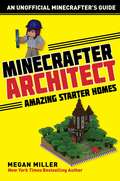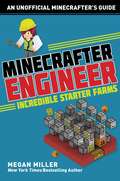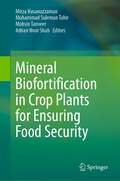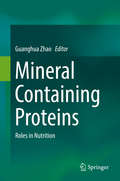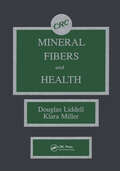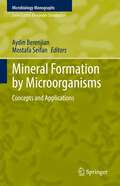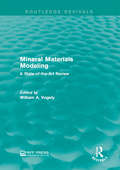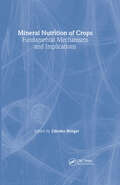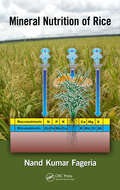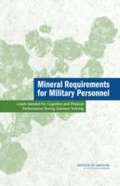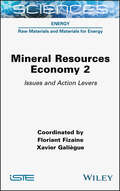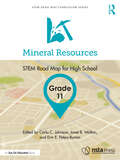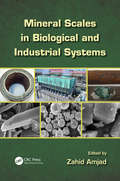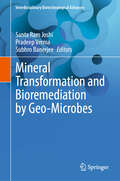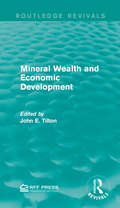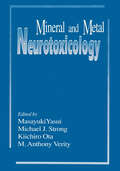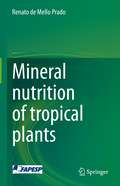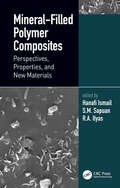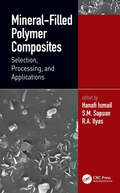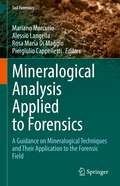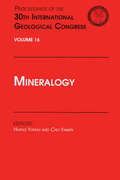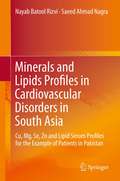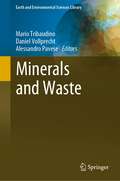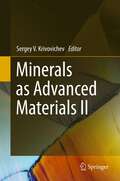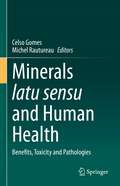- Table View
- List View
Minecrafter Architect: Amazing Starter Homes (Architecture for Minecrafters)
by Megan MillerThe Architecture for Minecrafters series is designed to encourage confidence and creativity by teaching kids to build a wide array of uniquely sophisticated structures. Each book in the series helps players follow blueprints to create impressive masterpieces that are as fantastic as they are functional. Minecrafter Architect: Amazing Starter Homes is the first in this inspiring new series. Guided by hundreds of in-game, step-by-step photos and simple instructions, kids will learn how to build one of ten amazing homes so that they can create interesting and reliable shelter anywhere they spawn. Igloo compounds, prairie houses, and llama ranches are just some of the killer designs that await them when they follow the techniques laid out in this book. With tips for adding d?cor and landscaping touches to their new builds, players can have fun bringing each new home to life. Perfect for beginner to advanced Minecrafters who want to learn more Includes hundreds of step-by-step, full-color photos to guide readers of all ages Helps encourage creativity and problem-solving skills Kids who want to try their hand at virtual design will love the tricks and tips inside this book! Minecrafter Architect: Amazing Starter Homes holds the valuable secrets they need to flex their in-game building skills.
Minecrafter Engineer: Incredible Starter Farms (Engineering for Minecrafters)
by Megan MillerThe Engineering for Minecrafters series is designed to encourage creativity and problem-solving skills in kids who love building in Minecraft. Each book helps players work within the physics of the game to build clever farms, ultra-efficient railways, automated redstone-fueled contraptions, and more. Minecrafter Engineer: Incredible Starter Farms is the first in this compelling and inspiring new series. Guided by hundreds of in-game, step-by-step photos and simple instructions, kids will learn how to engineer one of seven spectacular farms to yield resources and goodies beyond their wildest dreams. Stacks of sugarcanes, gobs of gold, and bushels of blaze rods are the rewards that await them when they follow the techniques laid out in this book. Perfect for beginner to advanced Minecrafters who want to learn more Includes hundreds of step-by-step, full-color photos to guide readers of all ages Helps encourage creativity and problem-solving skills They?re not an expert gamer until they learn the tricks and tips in this book! Minecrafter Engineer: Incredible Starter Farms holds the valuable secrets to becoming the Minecrafter engineer they?ve always wanted to be.
Mineral Biofortification in Crop Plants for Ensuring Food Security
by Mirza Hasanuzzaman Mohsin Tanveer Muhammad Suleman Tahir Adnan Noor ShahThis book provides a comprehensive summary of the recent advances in the biofortification of plants under climate change and how it affects food security globally. The need for mineral biofortification to eradicate or alleviate malnutrition through sustainable agriculture is also discussed. Biofortification of edible plants is considered the most appropriate approach to alleviate nutritional problems and nutrient deficiencies. In contrast, biofortification focuses on improving the nutritional content of the region's current agricultural biodiversity while preserving its habits and customs. Emphasis is also placed on recent advances and developments in omics, particularly metabolomics and related techniques, to unravel the potential alterations in plants caused by biofortification. The book brings together eminent scientists to present the latest developments in the field. This timely publication addresses practical scenarios of bio-fortified food production and climate change. The book focuses on the methods, techniques, and environmental changes used to enhance and improve agricultural products. This book is one of the first to provide information on the use of modern biotechnologies to modify crops for health benefits. It also examines the mechanisms of the plant responses to genetically induced biofortification, the production and responses of fortified plants under climate change, and their effects on food security. The book will be useful for students and researchers, especially crop scientists, environmental scientists, biotechnologists, botanists, and agronomists, to understand the techniques and mechanisms of biofortification, and responses of biofortified plants under climate change.
Mineral Containing Proteins
by Guanghua ZhaoThis book describes the structure, function and nutritional values of iron-, zinc-, selenium- and calcium-containing proteins, exploring key mineral-containing proteins like phytoferritin and lactoferrin, as well as a host of zinc- and selenium-containing proteins. Due to their role in numerous metabolic processes, minerals such as calcium, iron, zinc and selenium are vital, and have to be obtained from a balanced diet because they cannot be synthesized. The structure and function of mineral-containing proteins influences the absorption of these essential minerals. As such, the study of these proteins is crucial for the assessment and maintenance of a balanced diet and for the development of effective mineral supplements. The book's closing chapters focus on issues arising from current food processing techniques and in the development of mineral supplements. The book offers a valuable guide for researchers and students in the fields of food chemistry and nutrition.
Mineral Fibers and Health
by F.D.K. Liddell Klara MillerThis text looks at mineral fibers, their occurrence, production, properties and their uses. The part of this book covering pathogensis and modes of action begins with a chapter on the physicochemical properties of asbestos fibers and a chapter on the deposition and retention of fibers within the lung and their clearance.
Mineral Formation by Microorganisms: Concepts and Applications (Microbiology Monographs #36)
by Aydin Berenjian Mostafa SeifanThis book explains how microorganisms play a pivotal role in the formation of biominerals, including carbonates, silicate minerals and oxides. As readers will learn, these minerals may be produced either intracellularly or extracellularly in order to sustain microbial life. Experienced scientists from the field show that some of these biominerals can be produced in an active form, which involves direct enzymatic intervention to form precipitates. In addition, passive mineral formation can be mediated by the presence of dead cells. Readers from Microbiology and Biochemistry will appreciate the thorough coverage on various types of microbial mineral formation and their roles in microbial domains. Furthermore, they will benefit from the authors’ first-hand knowledge regarding common techniques for studying biomineral-producing microorganisms, factors affecting biomineralization, and the use of this process in biotechnological applications.
Mineral Materials Modeling: A State-of-the-Art Review (Routledge Revivals)
by William A. VogelyOriginally published in 1976, this study was undertaken to fill a gap in knowledge about non-fuel resources and the advantages and disadvantages of specific methodologies of analysing material modelling. Mineral Materials Modeling examines the influence of factors such as raw material price and availability, technological aspects and related environmental questions in relation to both economic and mathematical models. The results are particularly helpful in terms of forecasting, policy development and decision-making about mineral materials as well as assessing the usefulness of different types of model. This title will be of interest to students of Environmental Studies as well as policy makers and professionals.
Mineral Nutrition of Crops: Fundamental Mechanisms and Implications
by Zdenko RengelThe first book on crop nutrition that covers topics from soil hydrology to molecular biology!The first book ever to elucidate so many different aspects of mineral nutrition of crops, Mineral Nutrition of Crops: Fundamental Mechanisms and Implications will allow you to grasp the complexity of the soil-water-plant-microbe interactions governing nutrient uptake and utilization by crops. By emphasizing a fundamental mechanistic approach, this book effectively complements the monograph Nutrient Use in Crop Production (The Haworth Press, Inc.). With Mineral Nutrition of Crops you will explore the many facets necessary to increase crop and pasture yields and minimize unwanted losses of nutrients to the environment.Mineral Nutrition of Crops covers a wide range of topics that span several scientific disciplines: agriculture, agronomy, botany, forestry, ecology, plant science, and soil science. From this book, you will gain vital knowledge required to understand the complexity of mechanisms and processes governing nutrient transport toward roots, including biological and chemical reactions influencing nutrient availability in the rhizosphere, uptake by root cells, long-distance transport toward grain, and the role of nutrients in metabolism. Also, you will explore issues relating to the following topics: biology and chemistry of nutrient availability in the rhizosphere kinetics of nutrient uptake by plant cells role of mineral photosynthesis and yield formation importance of seed nutrient reserves in crop growth and development breeding crops for improved nutrient efficiency significance of root size for plant production monitoring water and nutrient fluxes down the profile From Mineral Nutrition of Crops , you will gain the knowledge you need to understand and improve methods of crop growth and nutrition. Mineral Nutrition of Crops is an indispensable manual for anyone involved in the many aspects of growing crops.
Mineral Nutrition of Rice
by N.K. FageriaThe third most important cereal crop after wheat and corn, rice is a staple food for more than half of the world's population. This includes regions of high population density and rapid growth, indicating that rice will continue to be a major food crop in the next century. Mineral Nutrition of Rice brings together a wealth of information on the eco
Mineral Requirements for Military Personnel: Levels Needed for Cognitive and Physical Performance During Garrison Training
by Institute of Medicine of the National AcademiesThe National Academies Press (NAP)--publisher for the National Academies--publishes more than 200 books a year offering the most authoritative views, definitive information, and groundbreaking recommendations on a wide range of topics in science, engineering, and health. Our books are unique in that they are authored by the nation's leading experts in every scientific field.
Mineral Resource Economy 2: Issues and Action Levers
by Florian Fizaine Xavier GaliègueThe challenges associated with the environmental impact of renewable energies are formidable and multiple. The exploitation of diffuse forms of energy will require us to reshape our lifestyles and infrastructures. Reducing their environmental impact is imperative and requires the mobilization of all available levers of action.Beyond the analysis of these challenges, this book presents an overview of the levers of action that should allow us to meet them, by crossing the fields of the human sciences, geosciences and engineering. The levers of action examined are both technical (through the substitution or use of low technology) and economic and social (through the development of recycling or decoupling). The book also addresses the question of their effectiveness and their overall impact.
Mineral Resources, Grade 11: STEM Road Map for High School (STEM Road Map Curriculum Series)
by Carla C. Johnson Erin E. Peters-Burton Janet B. WaltonWhat if you could challenge your eleventh graders to come up with a design solution for developing, managing, and utilizing mineral resources? With this volume in the STEM Road Map Curriculum Series, you can! Mineral Resources outlines a journey that will steer your students toward authentic problem solving while grounding them in integrated STEM disciplines. Like the other volumes in the series, this book is designed to meet the growing need to infuse real-world learning into K–12 classrooms. This interdisciplinary, three-lesson module uses project- and problem-based learning to help students develop an in-depth understanding of mineral resources by researching the utility and impact of particular mineral resources on society. Working in teams, students will locate quantitative and qualitative data on mineral resources and discern the reliability of the information, then use their data to write an opinion article and develop a website to convince readers of the effectiveness of a particular design solution for developing, managing, and utilizing mineral resources. To support this goal, students will do the following: Explain how mineral resources are located and used in various ways in society. Explain why mineral resources are important to society. Critically evaluate quantitative and qualitative data about mineral resources. Write an opinion article demonstrating their knowledge about competing design solutions for extracting mineral resources. The STEM Road Map Curriculum Series is anchored in the Next Generation Science Standards, the Common Core State Standards, and the Framework for 21st Century Learning. In-depth and flexible, Mineral Resources can be used as a whole unit or in part to meet the needs of districts, schools, and teachers who are charting a course toward an integrated STEM approach.
Mineral Scales in Biological and Industrial Systems
by Zahid AmjadSoluble and insoluble impurities present in water used for domestic and industrial applications can lead to the deposition of unwanted materials on equipment surfaces. Impurities such as dissolved minerals, natural organic compounds, and suspended particles can impact various processes and systems including boiling and cooling processes, desalinati
Mineral Transformation and Bioremediation by Geo-Microbes (Interdisciplinary Biotechnological Advances)
by Pradeep Verma Santa Ram Joshi Subhro BanerjeeThis book investigates the pivotal role of microorganisms in elemental cycling and degradation processes, offering a comprehensive exploration of their chemical reactivity and metabolic diversity. By examining the interaction of microorganisms with geological activities, this volume highlights their influence on biotransformation and bioremediation. Readers will find an in-depth review of geo-microbes' applications in soil improvement and environmental restoration, alongside discussions on bio-sediment, bioleaching, and elemental cycling. The chapters offer expert analysis and diverse perspectives in microbiology, geology, and environmental biotechnology. Key concepts include the geomicrobiological interactions in extreme environments, the transformation of toxic elements, and the potential for extraterrestrial life models. Chapters delve into the rehabilitation of saturated lands, the role of geo-microbes in arsenic transformation, and the ecological restoration of wetlands. The book is invaluable for researchers, students, and professionals in microbiology, biotechnology, geology, and environmental sciences. It also serves as a major reference for understanding the microbial processes that shape our planet and offers practical insights for harnessing the power of geo-microbes for sustainable environmental solutions. While comprehensively reviewing geo-microbes in biotransformation processes, the book provides the knowledge and tools necessary to advance the readers’ understanding of geomicrobiology and its applications.
Mineral Wealth and Economic Development (Routledge Revivals)
by John E. TiltonOver the last several decades, many low-income mineral exporting countries have seen their per capita income decline or their standard of living stagnate. In this title, prominent analysts identify reasons behind the distressing economic performance of these countries including ineffective public policies, political misuse of mineral rents, and the deleterious effects of economic nationalism on the foreign investment climate in developing countries. Originally published in 1992, this title remains relevant for students interested in environmental studies and public policy.
Mineral and Metal Neurotoxicology
by Masayuki Yasui M. Anthony VerityTrace minerals and metals such as zinc, copper, and magnesium are accepted as a "natural" part of the human system. Interactions of some elements and/or disturbances in trace-metal or mineral homeostasis can, however, be toxic to the central nervous system (CNS). Mineral and Metal Neurotoxicology describes a wide range of basic and clinical issues
Mineral nutrition of tropical plants
by Renato de Mello PradoThis textbook aims to describe the role of minerals in plant life cycle; how these nutrients are absorbed, distributed, stored; what functions each mineral plays and the disorders that their excess or absence may cause. From an agronomic perspective, such knowledge is key to boost crop production and improve its quality, and it also helps understand how to better manage fertilizers and prevent environmental issues. The book has focus on tropical agriculture and its specific demands, providing examples of major crops (such as sugarcane, soybeans, coffee etc), silviculture and pasture species.
Mineral-Filled Polymer Composites: Perspectives, Properties, and New Materials
by S. M. Sapuan R. A. Ilyas Hanafi IsmailMineral-filled polymer composites are widely used in industries across the globe, and applications are continuously increasing in sectors such as shipping, manufacturing and renewable energy. One of two volumes comprising the Mineral-Filled Polymer Composites Handbook, this volume provides an overview of the latest research and future directions of advanced mineral fiber-reinforced polymer composites, focused specifically on materials properties. It covers fundamentals, recent progress and new materials involved in mineral-filled polymer composites and includes a wide-ranging list of chapters authored by an international team of experts. This book: Examines the properties of a wide range of materials, from macro- to nano-sized Highlights resources for bio-based minerals production and compares bio-based minerals with commercial mineral fillers Covers novel synthesis methods Discusses effects of aging on properties Describes using halloysite and montmorillonite to improve composite properties and the potential of using mineral fillers to enhance the properties of biopolymer and synthetic polymers This book serves as an excellent reference guide for researchers, advanced students, academics and industry professionals interested in the synthesis of mineral-filled polymer and biopolymer composites, as well as those pursuing research in the broad fields of composite materials, polymers, organic/inorganic hybrid materials and nano-assembly.
Mineral-Filled Polymer Composites: Selection, Processing, and Applications
by S. M. Sapuan R. A. Ilyas Hanafi IsmailMineral-filled polymer composites are increasingly used for various applications, including automotive, construction, biomedical, maritime, sport and ballistic, due to the advantages of low cost, light weight, excellent rigidity and high mechanical strength. One of two volumes comprising the Mineral-Filled Polymer Composites Handbook, this volume provides an overview of the latest research, trends, applications and future directions of advanced mineral fiber-reinforced polymer composites. It focuses specifically on material selection, processing and applications. This book: Emphasizes the principles governing the behavior of mineral-filled composite materials in the field of engineering and their applications Covers systematic material selection tools such as analytical hierarchy process (AHP), analytical network process (ANP), and technique of ranking preferences by similarity of the ideal solution (TOPSIS) Reviews the use of these materials for various engineering applications Features chapters looking at fabrication techniques and frictional properties Details current research in polymer nanocomposites and particulate polymer composites This book serves as an excellent reference guide for researchers, advanced students, academics and industry professionals interested in the synthesis of mineral-filled polymer and biopolymer composites, as well as those pursuing research in the broad fields of composite materials, polymers, organic/inorganic hybrid materials and nano-assembly.
Mineralogical Analysis Applied to Forensics: A Guidance on Mineralogical Techniques and Their Application to the Forensic Field (Soil Forensics)
by Rosa Maria Di Maggio Mariano Mercurio Alessio Langella Piergiulio CappellettiThis book illustrates the main modern mineralogical analytical procedures that can be applied for forensic purposes on various typologies of materials and substances and has both theoretical and practical approach. Moreover, it focuses on all those challenges that can arise with forensic analysis, such as the choice of the most proper mineralogical techniques as a function of the material and its quantity, destructive and non-destructive analyses, sampling procedures, mineralogical analysis of micro-traces, correct preparation of the samples, correct calibration and analytical conditions of the laboratory instrumentation. Numerous case studies on criminal offenses against persons, environment and cultural heritage are illustrated.
Mineralogy: Proceedings of the 30th International Geological Congress, Volume 16
by Huang Yunhui Cao YawenThis book is a collection of papers presented in the 30th International Geological Congress, held in Beijing, on mineralogy. The papers deal with topics on fine structures and crystallographic orientations in biogenic magnetite and thermodynamic properties of minerals.
Minerals and Lipids Profiles in Cardiovascular Disorders in South Asia
by Nayab Batool Rizvi Saeed Ahmad NagraThis book correlates different minerals and lipids serum profiles with the prevalence of cardiovascular disorders in South Asian countries with special emphasis on Pakistan. Cardiovascular disorders (CVD, e. g. coronary heart diseases, hypertension, rheumatic heart disease, angina, heart failure and deep vein thrombosis) show significantly increasing rates in South Asian countries like Pakistan and have become a major health problem. Nevertheless, the data on any aspect of cardiovascular problems still is scanty. The serum profiles of different minerals (copper, magnesium, zinc, selenium) and lipids are analyzed in detail. The presented data will thus lead to a better understanding of the problem and help to provide possible solutions, which can be achieved, e. g. through ameliorated minerals profiles in the daily diet. These results can help develop better dietary management strategies in the prevention and treatment of CVD.
Minerals and Waste (Earth and Environmental Sciences Library)
by Mario Tribaudino Daniel Vollprecht Alessandro PaveseIn the field of waste disposal, recovery, and recycling, industrial residues from ceramic and mining activities are just an assemblage of minerals. So is municipal waste, after removing the organic part in incinerators or after long-time disposal. In almost every case, a natural counterpart is present. Applying what is known from natural systems on waste assemblages is the key to predicting their fate, at a short and long time, and suggesting the best for high-temperature recycling.This book aims to bring the Earth Science community to the edge of waste management, offering background information, the basics of high and low-temperature geochemistry involved, and an overview of waste investigation connected to minerals. This book also addresses mineral tailings, incinerator bottom, fly ashes, metal slags, ceramic industry residue, and eventually sanitary issues.The primary readership will be graduate students and professionals in geological and environmental fields.
Minerals as Advanced Materials II
by S V KrivovichevThis book is a collection of papers that are devoted to various aspects of interactions between mineralogy and material sciences. It will include reviews, perspective papers and original research papers on mineral nanostructures, biomineralization, micro- and nanoporous mineral phases as functional materials, physical and optical properties of minerals, etc. Many important materials that dominate modern technological development were known to mineralogists for hundreds of years, though their properties were not fully recognized. Mineralogy, on the other hand, needs new impacts for the further development in the line of modern scientific achievements such as bio- and nanotechnologies as well as by the understanding of a deep role that information plays in the formation of natural structures and definition of natural processes. It is the idea of this series of books to provide an arena for interdisciplinary discussion on minerals as advanced materials.
Minerals latu sensu and Human Health: Benefits, Toxicity and Pathologies
by Michel Rautureau Celso GomesThis volume provides a comprehensive academic review of both positive and negative effects of minerals on human health and quality of life. The book adopts the concept of mineral latu sensu (mineral l.s.), which encompasses a broad spectrum of natural, inorganic, solid, and crystalline, of natural and inorganic chemical elements (metals and metalloids), of modified natural minerals, of biominerals, and of syntetic minerals, all products that branch across the disciplines of earth, soil, environmental, materials, nutrition, and health sciences. Using this broad framework, the authors are able to provide a multidisciplinary assessment on many types of minerals which can be essential, beneficial and hazardous to human health, covering applications in medical geology, medical hydrology or balneotherapy, pharmacology, chemistry, nutrition, and biophysics. The book performs historical analyses of the uses of minerals for therapeutic and cosmetic purposes to better understand current trends and developments in mineral research and human health. The book will be of interest to students, public health officials, environmental agencies and researchers from various disciplines, as well as scientific societies and organizations focusing on medical geology, health resort medicine (crenotherapy, hydrotherapy and climatotherapy), and on pharmaceutical, cosmetic and biomedical applications.
